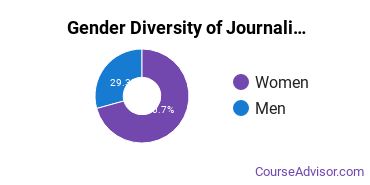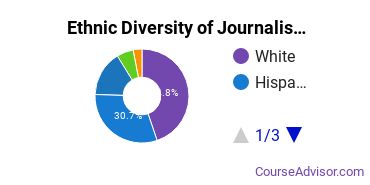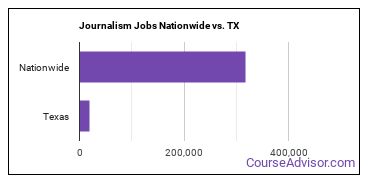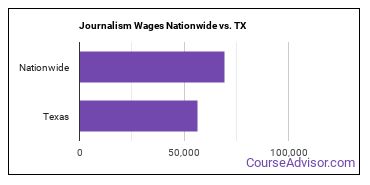Journalism Schools in Texas
742 Journalism students earned their degrees in the state in 2022-2023.
A Journalism major is the 68th most popular major in this state.
Education Levels of Journalism Majors in Texas
Journalism majors in the state tend to have the following degree levels:
| Education Level | Number of Grads |
|---|---|
| Bachelor’s Degree | 656 |
| Master’s Degree | 40 |
| Associate Degree | 35 |
| Doctor’s Degree (Research / Scholarship) | 6 |
| Doctor’s Degree (Professional Practice) | 6 |
| Doctor’s Degree (Other) | 6 |
| Post-Master’s Certificate | 5 |
| Postbaccalaureate Certificate | 5 |
Gender Distribution
In Texas, a journalism major is more popular with women than with men.

Racial Distribution
The racial distribution of journalism majors in Texas is as follows:
- Asian: 3.0%
- Black or African American: 13.9%
- Hispanic or Latino: 28.3%
- White: 48.2%
- Non-Resident Alien: 1.8%
- Other Races: 4.9%

Jobs for Journalism Grads in Texas
There are 19,270 people in the state and 318,590 people in the nation working in journalism jobs.

Wages for Journalism Jobs in Texas
A typical salary for a journalism grad in the state is $56,680, compared to a typical salary of $69,480 nationwide.

Most Popular Journalism Programs in TX
There are 10 colleges in Texas that offer journalism degrees. Learn about the most popular 10 below:
95% of students get financical aid. This public college charges it's students an average net price of $15,205. Of all the teachers who work at the school, 73% are considered full time.
Request InformationOf all the teachers who work at the school, 83% are considered full time. This public school has an average net price of $18,850. 89% of students get financical aid.
Request InformationMost students complete their degree in 4.59 years. This public college charges it's students an average net price of $13,900. Of all the students who attend this school, 83% get financial aid.
Request Information15 to 1 is the student to faculty ratio. Most students complete their degree in 4.21 years. Seeking financial aid? At this school, 97% of students receive it.
Request InformationOf all the teachers who work at the school, 67% are considered full time. This private school has an average net price of $40,849. Students enjoy a student to faculty ratio of 11 to 1.
Request Information74% of the teachers are full time. Students enjoy a student to faculty ratio of 21 to 1. Most students complete their degree in 4.56 years.
Request InformationMost students complete their degree in 4.15 years. Of all the students who attend this school, 92% get financial aid. Students who attend this private institution pay an average net price of $39,271.
Request InformationThe student to faculty ratio is 18 to 1. 65% of students are awarded financial aid at this school. Of all the teachers who work at the school, 40% are considered full time.
Request InformationThis public school has an average net price of $18,012. Seeking financial aid? At this school, 99% of students receive it. The student to faculty ratio is 18 to 1.
Request InformationStudents enjoy a student to faculty ratio of 21 to 1. 88% of students get financical aid. Most students complete their degree in 4.49 years.
Request InformationJournalism Careers in TX
Some of the careers journalism majors go into include:
| Job Title | TX Job Growth | TX Median Salary |
|---|---|---|
| Film and Video Editors | 21% | $47,160 |
Related Majors in Texas
Below are some popular majors in the state that are similar to journalism.
| Major | Annual Graduates in TX |
|---|---|
| Communication & Media Studies | 4,091 |
| Public Relations & Advertising | 1,985 |
| Radio, TV & Digital Communication | 1,511 |
| Publishing | 5 |
View all majors related to Journalism
Explore Major by State
Alabama
Arkansas
Connecticut
Florida
Idaho
Iowa
Louisiana
Massachusetts
Mississippi
Nebraska
New Jersey
North Carolina
Oklahoma
Rhode Island
Tennessee
Vermont
West Virginia
View Nationwide Journalism Report
References
- College Factual
- National Center for Education Statistics
- O*NET Online
- Image Credit: By Jfurrer under License
More about our data sources and methodologies.









